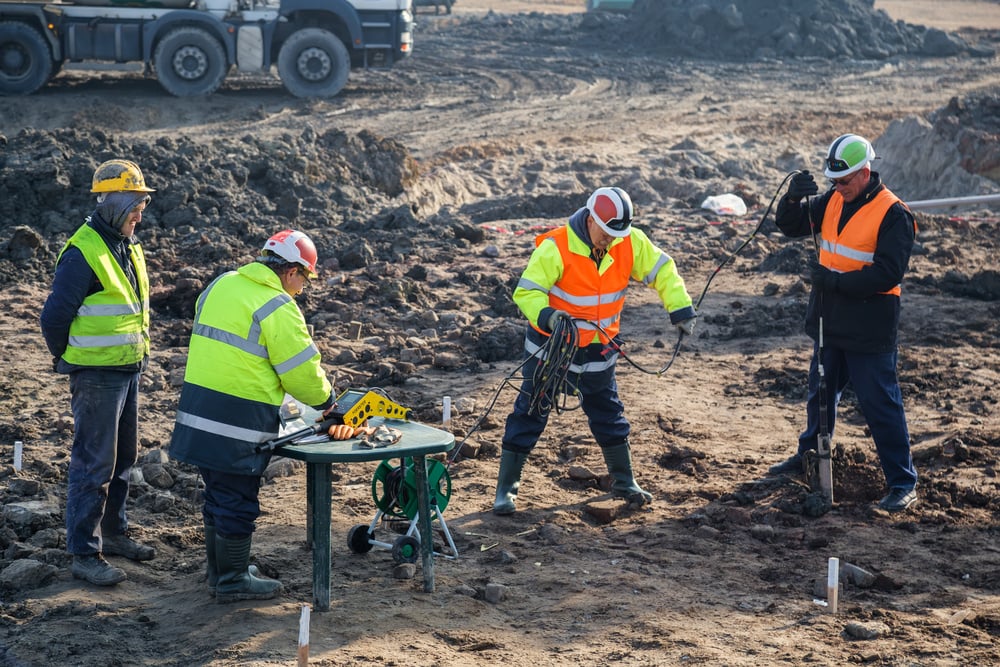What Does Geotechnical Engineering For Construction Projects Mean?
What Does Geotechnical Engineering For Construction Projects Mean?
Blog Article
Geotechnical Engineering For Construction Projects Things To Know Before You Buy
Table of ContentsGetting The Geotechnical Engineering For Construction Projects To WorkThe smart Trick of Geotechnical Engineering For Construction Projects That Nobody is Talking AboutThe Best Guide To Geotechnical Engineering For Construction ProjectsOur Geotechnical Engineering For Construction Projects StatementsThe Facts About Geotechnical Engineering For Construction Projects UncoveredThe 5-Minute Rule for Geotechnical Engineering For Construction ProjectsGeotechnical Engineering For Construction Projects Fundamentals Explained
Concepts and Practice of Ground Enhancement. Ground Enhancement Concepts And Applications In Asia. Layout analysis in rock technicians.Cengage Understanding, Stamford, 666 p. Atkinson, J., 2007. The auto mechanics of soils and structures. The Observational Technique in ground design principles and applications.
Geotechnical Engineering For Construction Projects - The Facts
Lab and area testing plays a critical function in this process. By removing samples from the earth's subsurface and applying a collection of tests, geotechnical engineers can forecast the behaviour of soil layers and examine their viability for various building and construction endeavours. The essence of geotechnical design in civil engineering can not be overstated, attributable to a number of elements: The preliminary action in any type of geotechnical research entails identifying the dirt kind at the building and construction site.
Comprehending these characteristics guarantees that just ideal soil types are picked for the growth, consequently preventing possible architectural failings. The structure acts as the bedrock of any kind of building project. Picking the suitable structure kind is a decision that pivots on the comprehensive evaluation provided by geotechnical design. This makes sure the durability and stability of frameworks by fitting the loads they will birth.

Geotechnical site examination is a vital action in the planning and execution of any type of building job. It entails the collection and analysis of information associated with the physical homes of soil and rock below a suggested construction site. This info is crucial for the style and construction of safe, secure, and lasting structures.
Some Ideas on Geotechnical Engineering For Construction Projects You Need To Know
In this blog site, we will delve right into the importance of geotechnical site investigation, its different parts, and exactly how it profits building and construction jobs. Geotechnical site investigation, also understood as subsurface exploration, involves a collection of tasks intended at figuring out the dirt, rock, and groundwater conditions at a construction site. The primary purposes are to determine potential geotechnical risks, evaluate the engineering homes of subsurface products, and give suggestions for the style and building and construction of foundations, retaining wall surfaces, and various other structures.
This may include geological maps, aerial photos, previous examination records, and historic data. The workdesk research assists in recognizing potential geotechnical issues and intending the subsequent fieldwork. Complying with the desk research study, a site reconnaissance is carried out to aesthetically evaluate the website and its environments. This involves observing the topography, drainage patterns, existing structures, greenery, and any type of indicators of instability or disintegration.
Geotechnical Engineering For Construction Projects Things To Know Before You Get This
Superficial test pits are dug deep into to straight observe and example the soil and rock. This approach is helpful for researching the upper layers of the subsurface and determining near-surface hazards. Non-invasive geophysical techniques, such as seismic refraction, ground-penetrating radar (GPR), and electric resistivity tomography (ERT), are used to map subsurface problems and spot abnormalities.
Dirt and rock samples collected throughout the field examination are subjected to research laboratory screening to establish their physical and mechanical homes. These examinations give important information for geotechnical evaluation and layout.
The main benefit of geotechnical site investigation is guaranteeing the security and security of structures. By understanding the subsurface conditions, engineers can develop foundations and other architectural aspects that can hold up against the lots and ecological pressures they will certainly undergo. This reduces the threat of negotiation, decrease, and structural failure.
Facts About Geotechnical Engineering For Construction Projects Revealed
This guarantees reliable and secure building methods. Geotechnical website investigations are usually needed by constructing codes and regulations.
This information is vital for job supervisors, engineers, and professionals in establishing sensible timetables, budgets, and contingency plans. Geotechnical Engineering for Construction Projects. High-Rise Structure in a Coastal AreaIn a coastal city, a high-rise property structure was planned on a website with thought loose sand down payments and a high water table. An in-depth geotechnical investigation, consisting of borehole drilling, CPT, and geophysical surveys, was conducted
All About Geotechnical Engineering For Construction Projects
Based upon these findings, the foundation layout was customized to include deep pile foundations extending right into stable strata, and ground improvement techniques, such as vibro-compaction, were implemented to minimize liquefaction dangers. This proactive technique made sure the safety and security of the structure while preventing expensive post-construction remediation. Facilities Advancement on a Sloping TerrainA major infrastructure project, including the building and construction of a highway and bridges, was intended on a sloping terrain with high inclines.

The Leaning Tower of Pisa (Italy), an iconic architectural wonder, pop over to this site is well known for its unplanned tilt from substantial geotechnical problems. The tower's foundation was improperly created to deal with the soft, unstable soil underneath it, resulting in unequal settlement and its distinctive lean. Our globe is populated with excellent infrastructure projectsfrom towering high-rises to sprawling bridgesall standing statement to the evolution of the different building and construction devices and approaches offered.
Geotechnical design is a specialized area within civil engineering that concentrates on researching the actions of planet products. This branch delves deep right into the groundinvestigating exactly how the dirt, rock, and groundwater at a building and construction site can influenceand be influenced bythe facilities that we put up on and right into them. Before a single brick is laid or a concrete structure put, geotechnical designers probe right into the earthgathering critical information concerning the website's dirt structure, rock structure, and groundwater degrees.
What Does Geotechnical Engineering For Construction Projects Mean?

is a device made use of to analyze the Read Full Report integrity and load-bearing capacity of piles during installation, leveraging the principle of wave proliferation. It enhances building effectiveness by supplying real-time examinations, hence guaranteeing risk-free and efficient stack structures. Among the sensible applications of geotechnical design entails choosing and carrying out the appropriate methods for structure building and construction.
Pile driving represents even more than the mere act of putting structural elements into the ground. On the contrary, it is a meticulously managed procedure of transferring a framework's lots past the less secure soil layers better to the surfacedown to the a lot more significant strata that lie beneath. In the situation of stack driving, take into consideration how geotechnical engineers skillfully utilize this method to equally disperse the framework's weight.
Report this page